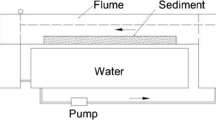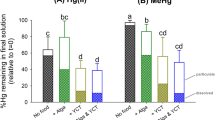Abstract
Cadmium-109 whole-body and internal biokinetics were experimentally investigated in critically endangered diamond sturgeon Acipenser gueldenstaedtii after uptake from water or food, in fresh (FW) and brackish (BW; 9‰) salinities typical of the Caspian Sea. Whole-body rates of uptake of 109Cd from water and subsequent depuration were quantified over 14 and 28 days, respectively. Uptake was greater in FW than BW by a factor of 2.4, but depuration rates were similar in both salinities. In contrast, for the dietary (chironomid) exposure pathway 109Cd assimilation efficiencies (AEs) were higher in BW (13%) compared to FW (9.5%). Head (including gills) or digestive tract were major repositories of 109Cd following aqueous and dietary exposures, respectively, including both uptake and depuration phases. The point-of-entry of 109Cd into the body was also a major and persistent determiner of its subsequent internal distribution. For aqueous exposures, the internal distributions of 109Cd changed appreciably during depuration with increased activity concentrations in some body components, which again varied with salinity. Increased salinity appreciably enhanced the percentage distributions and activity concentrations of 109Cd in the liver, kidney and digestive tract, which are typically most pathologically altered by elevated Cd exposure. For dietary exposure, increased salinity also enhanced 109Cd activity concentrations in most body components. The results repeatedly indicate the important role of salinity in the whole-body and internal biokinetics of 109Cd in A. gueldenstaedtii, a representative of both a phylogenetically distinct and most endangered family of fishes.





Similar content being viewed by others
References
Adel M, Saravi HN, Dadar M, Niyazi L, Ley-Quinonez CP (2017) Mercury, lead, and cadmium in tissues of the Caspian pond turtle (Mauremys caspica) from the southern basin of Caspian Sea. Environ Sci Pollut Res 24:3244–3250. https://doi.org/10.1007/s11356-015-5905-5
APHA (2005) Standard methods for the examination of water and wastewater, 21st edn. American Public Health Association American Water Works Association and Water Environment Federation, Washington
Banan A, Forouharmehr A, Kalbassi MR, Esmaeilbeigi M, Bahmani M, Sadati MY, Kolok AS, Rogan EG (2022) Salinity gradients exacerbate the genotoxicity and bioaccumulation of silver nanoparticles in fingerling Persian sturgeon (Acipenser persicus). Reg Stud Mar Sci 52:102264. https://doi.org/10.1016/j.rsma.2022.102264
Brown PL, Markich SJ (2000) Evaluation of the free ion activity model of metal-organism interaction: extension of the conceptual model. Aquat Toxicol 51:177–194. https://doi.org/10.1016/S0166-445X(00)00115-6
Chuctaya J, Ferrer J, Ferrari A, Vianna RT, Malabarba LR (2019) On the spread of the Russian sturgeon Acipenser gueldenstaedtii (Acipenseriformes: Acipenseridae) in the neotropics: A marine path to invade freshwater drainages in South America? J Appl Ichthyol 35:396–400. https://doi.org/10.1111/jai.13826
Clark KR, Gorley RN (2015) Primer v7; User manual/tutorial. PRIMER-E, Plymouth, p. 296.
Cullen JT, Maldonado MT (2013) Biogeochemistry of cadmium and its release to the environment. In: Sigel A, Sigel H, Sigel RK (eds) Cadmium: from toxicity to essentiality. Springer, Dordrecht, pp 31–62
de Mora SJ, Turner T (2004) The Caspian Sea: a microcosm for environmental science and international cooperation. Mar Pollut Bull 48:26–29. https://doi.org/10.1016/j.marpolbul.2003.10.021
Doering JA, Beitel SC, Eisner BK, Heide T, Hollert T, Giesy JP, Hecker M, Wiseman SB (2015) Identification and response to metals of metallothionein in two ancient fishes: white sturgeon (Acipenser transmontanus) and lake sturgeon (Acipenser fulvescens). Comp Biochem Physiol C 171:41–48. https://doi.org/10.1016/j.cbpc.2015.03.002
European Union (2006) Commission regulation (EC) No 1881/2006 of 19 December setting maximum levels for certain contaminants in foodstuff, 2006R1881 EN 01.09.2014 014.001 1, p 36
Genchi G, Sinicropi MS, Lauria G, Carocci A, Catalano A (2020) Review: the effects of cadmium toxicity. Int J Environ Res Public Health 17:3782. https://doi.org/10.3390/ijerph17113782
Gesner J, Freyhof J, Kottelat M (2022) Acipenser gueldenstaedtii. The IUCN red list of threatened species. e.T232A13042340. https://www.iucnredlist.org/species/232/135063140
Glover CN, Bucking C, Wood CM (2013) The skin of fish as a transport epithelium: a review. J Comp Physiol B 183:877–891. https://doi.org/10.1007/s00360-013-0761-4
Gustafsson JP (2016) Visual MINTEQ (Version 3.1): a windows version of MINTEQA2. https://vminteq.com/
Jeffree RA, Warnau M, Teyssie J-L, Markich SJ (2006) Comparison of the bioaccumulation from seawater and depuration of heavy metals and radionuclides in the spotted dogfish Scyliorhinus canicula (Chondrichthys) and the turbot Psetta maxima (Actinopterygii: Teleostei). Sci Total Environ 368:839–852. https://doi.org/10.1016/j.scitotenv.2006.03.026
Jeffree RA, Oberhaensli F, Teyssie J-L (2010) Phylogenetic consistencies among chondrichthyan and teleost fishes in their bioaccumulation of multiple trace elements from seawater. Sci Total Environ 408:3200–3210. https://doi.org/10.1016/j.scitotenv.2010.04.015
Jeffree RA, Markich SJ, Oberhaensli F, Teyssie J-L (2017) Radionuclide biokinetics in the Russian sturgeon and phylogenetic consistencies with cartilaginous and bony marine fishes. J Environ Radioact 177:266–279. https://doi.org/10.1016/j.jenvrad.2017.06.007
Karpinski MG, Katunin DN, Goryunova VB, Shiganova TA (2005) Biological features and resources. In: Kostianoy AG, Kosarev AN (eds) The Caspian sea environment. Springer, Berlin, pp 191–210
Khodorevskaya RP, Dovgopol GF, Zhuravleva OL, Vlasenko AD (1997) Present status of commercial stocks of sturgeons in the Caspian Sea basin. Env Biol Fishes 48:209–219. https://doi.org/10.1023/A:1007381418332
Lee JW, Jo AW, Choi C, Kim JH (2023) Review of cadmium toxicity effects on fish: oxidative stress and immune responses. Environ Res. https://doi.org/10.1016/j.envres.2023.116600
Madani SAM, Harami SRM, Rezaee NPA (2022) Distribution, risk assessment, and source identification of traces metal pollution along the Babolsar coastal area, Caspian Sea. Environ Sci Pollut 29:89121–89131. https://doi.org/10.1007/s11356-022-21991-4
Maret W, Moulis JM (2013) The bioinorganic chemistry of cadmium in the context of its toxicity. In: Sigel A, Sigel H, Sigel RK (eds) Cadmium: from toxicity to essentiality. Springer, Dordrecht, pp 1–29
Markich SJ (2017) Thermodynamic data (log K) for environmentally-relevant elements, 3rd edn. ASI C1/17. Aquatic Solutions International, Sydney
Markich SJ, Brown PL, Batley GE, Apte SC, Stauber JL (2001) Incorporating metal speciation and bioavailability into water quality guidelines for protecting aquatic ecosystems. Australas J Ecotoxicol 7:109–122
Mazlum RE, Alabdullah A (2020) Gastric evacuation in endangered Russian sturgeon (Acipenser gueldenstaedtii): Effects of body and meal sizes. J Appl Ichthyol 36:39–45. https://doi.org/10.1111/jai.13984
Mazlum RE, Kurtoğlu İZ, Alabdullah A (2020) Effects of meal and body sizes on gastric evacuation of the endangered Siberian sturgeon (Acipenser baerii) fed on either live or artificial diets: Using radiography technique. Aquacult Res 51:1507–1512. https://doi.org/10.1111/are.14498
Mota JP, Encinar JR, Campa RF, Alonso JI, Sanz-Medel A (1999) Determination of cadmium in environmental and biological reference materials using isotope dilution analysis with a double focussing ICP-MS: a comparison with quadrupole ICP-MS. J Anal At Spectrom 14:1467–1473. https://doi.org/10.1039/A901753D
Okocha RC, Adedeji OB (2011) Overview of cadmium toxicity in fish. J Appl Sci Res 7:1195–1207. https://doi.org/10.3390/toxics10100622
Pouil S, Bustamante P, Warnau M, Metian M (2018) Overview of trace element trophic transfer in fish through the concept of assimilation efficiency. Mar Ecol Prog Ser 588:243–254. https://doi.org/10.3354/meps12452
Ruban GI, Khodorevskayab RP, Shatunovskiy MI (2019) Long-term dynamics of sturgeon distribution in the northern part of the Caspian Sea (review). Inland Wat Biol 12:443–451. https://doi.org/10.1134/S1995082919040126
Shaikhiev IG, Kraysman NV, Sverguzova SV, Spesivtseva SE, Yarothckina AN (2020) Fish scales as a biosorbent of pollutants from wastewaters and natural waters (a literature review). Biointerface Res Appl Chem 10:6893–6905. https://doi.org/10.33263/BRIAC106.68936905
Shen Y, Yang N, Liu Z, Chen Q, Li Y (2020) Phylogenetic perspective on the relationships and evolutionary history of the Acipenseriformes. Genomics 112:3511–3517. https://doi.org/10.1016/j.ygeno.2020.02.017
Szebedinksy C, McGeer JC, McDonald DG, Wood CM (2001) Effects of chronic Cd exposure via the diet or water on internal organ-specific distribution and subsequent gill Cd uptake kinetics in juvenile rainbow trout (Oncorhynchus mykiss). Environ Toxicol Chem 20:597–607. https://doi.org/10.1897/1551-5028(2001)020%3c0597:eoccev%3e2.0.co;2
Thophon S, Kruatrachue M, Upatham ES, Pokethitiyook P, Sahaphong S, Jaritkhuan S (2003) Histopathological alterations of white seabass, Lates calcarifer, in acute and subchronic cadmium exposure. Environ Pollut 121:307–320. https://doi.org/10.1016/S0269-7491(02)00270-1
Tuzhilkin VS, Katunin DN, Nalbandov YR (2005) Natural chemistry of Caspian Sea waters. In: Kostianoy AG, Kosarev AN (eds) The Caspian sea environment. Springer, Berlin, pp 83–108
Ure AM, Davidson CM (2001) Chemical speciation in the environment, 2nd edn. Blackwell Science, London
Whicker FW, Schultz V (1982) Radioecology: nuclear energy and the environment, vol 2. CRC Press, Boca Raton
Zahedi S, Akbarzadeh A, Rafati M, Banaee M, Heshmat M, Moghadam S, Raeici H (2013) Biochemical responses of juvenile European sturgeon, (Huso huso) to a sub-lethal level of copper and cadmium in freshwater and brackish water environments. J Environ Health Sci Eng 11:26
Acknowledgements
The IAEA is grateful for the support provided to its Marine Environment Laboratories by the Government of the Principality of Monaco. Drs Scott Fowler, Graeme Batley and Mat Johansen are thanked for comments and advice on the draft manuscript. Two anonymous reviewers are also thanked for their comments which improved to manuscript.
Funding
No funds or other support were received for the preparation of this manuscript.
Author information
Authors and Affiliations
Contributions
RAJ, FO and J-LT all contributed to the study design and performed the experiment; SJM undertook the speciation modelling and; RAJ and SJM collaborated in the writing and preparation of the manuscript for submission.
Corresponding author
Ethics declarations
Conflict of interest
The authors have no other financial or non-financial interests to disclose.
Supplementary Information
Below is the link to the electronic supplementary material.
Rights and permissions
Springer Nature or its licensor (e.g. a society or other partner) holds exclusive rights to this article under a publishing agreement with the author(s) or other rightsholder(s); author self-archiving of the accepted manuscript version of this article is solely governed by the terms of such publishing agreement and applicable law.
About this article
Cite this article
Jeffree, R.A., Markich, S.J., Oberhaensli, F. et al. Cadmium-109 Internal Kinetics in Diamond Sturgeon Acipenser gueldenstaedtii are Strongly Influenced by Salinity, Exposure Pathway and History. Arch Environ Contam Toxicol 85, 374–389 (2023). https://doi.org/10.1007/s00244-023-01031-z
Received:
Accepted:
Published:
Issue Date:
DOI: https://doi.org/10.1007/s00244-023-01031-z




